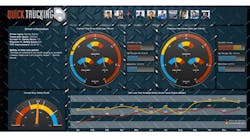Know that classic rock song, “In the Year 2525,” by Zager & Evans? It became an inside joke among some of us attending MHI’s last Material Handling & Logistics U.S. Roadmap meeting, held in Chicago this week. Other regional meetings took place over the last couple months in Atlanta, Washington, DC, and Los Angeles. All of them were dedicated to discussing the future of what you and I have devoted our careers to.
The stated purpose of these meetings was to gather together in one place a community of thought leaders with a stake in the future of material handling and logistics technologies and practices and to identify the challenges and opportunities facing them and those who will follow them.
I’m not at liberty to give you the details of what we discussed—MHI has reserved that right, and will do so once they’ve had time to digest all the notes the breakout groups generated. I can tell you, though, that the year 2025 was the timeframe of our assignments, and we were to share our collective visions of the state of material handling and logistics by the time that year rolls around.
To those of us in the group who grew up in the 60s and 70s, we couldn’t help but think of that pessimistic but infectious rock song. I will share with you that most everybody in our group expects that in the year 2025there will not only be real-time visibility of supply chain flows, but it will be predictive visibility. We will have the best supply chains, and technologies will capture terabytes of consumer data so that those who need to know it can make intelligent decisions about it.
So when I got back in the office this morning, what do I find in my e-mail box but a report from the Consumer Goods Forum (CGF), Capgemini and Roland Berger. Together they surveyed more than 200 consumer goods and retail executives about the state of their industries. Believe it or not, they’re not so upbeat about the state of some of the enabling technologies we discussed in Chicago.
These researchers determined that there is a need to establish guidelines for digital engagement with consumers in light of heightened consumer concerns about the use of their data by a variety of agencies.
At the same time, these researchers suggest that technology standards like those surrounding bar codes need updating in order to keep up with consumer data usage via smartphones and other mobile devices. This report cites a prior report from Capgemini and GS1, stating that 91% of mobile barcode scans returned incorrect or missing product descriptions, impacting consumer trust.
“Consumer barcodes do not uniquely identify product or package variations that carry the same product identifier, meaning minor product variations cannot be accurately disclosed,” say the authors of “Future Value Chain 2022,” which summarizes the scope of this research. “Also, when the product identifier needs to change to reflect new information, it adds waste to the system in the form of out-of-stocks, remnant inventory and transition costs.”
Capgemini says this project will document requirements for the “next generation” consumer product identifier, and the researchers will work with GS1 to recommend a standards-based solution and develop the business case needed to support global adoption. The ultimate goal: “Decreased waste in our supply chains and improved availability of accurate data for consumers, manufacturers, retailers and data aggregators.”
The year 2025 is less than 12 years away. For the sake of my fellow pundits who gathered in Chicago with such great expectations for the future state of our art, I hope those researchers reach their goal well before then. And I hope Zager & Evans’ vision of predictive logistics 1500 years from now is way off target:
“In the year 3535
Ain't gonna need to tell the truth, tell no lies
Everything you think, do, and say
Is in the pill you took today.”


